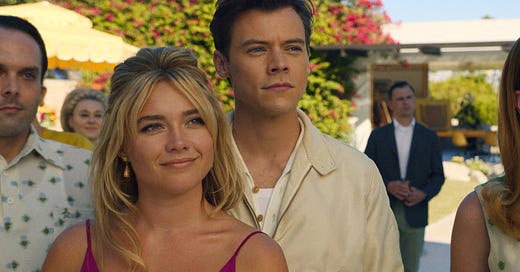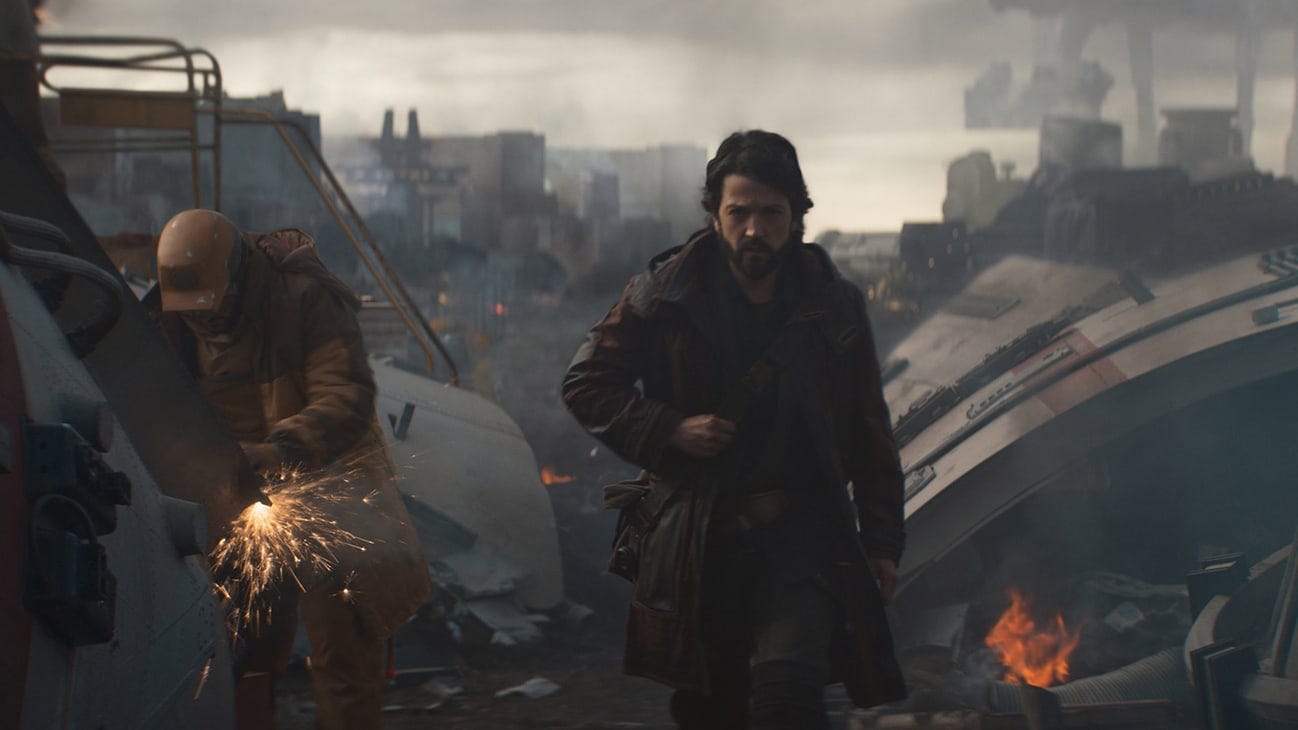Weekend Watch: Don't Worry Darling, Andor
Paranoia in the desert and rebellion in the galaxy far, far away.
Image Credit: Warner Bros.
Welcome to the latest edition of Weekend Watch, in which I recommend (or occasionally warn against) movies or TV shows I’ve been checking out. This week, Florence Pugh’s feeling suspicious and Diego Luna is getting rebellious. Follow James on Twitter: @jamwhite
Arriving on a wave of tabloid notoriety and festival tittle-tattle, Olivia Wilde’s second film faces an uphill struggle to distance itself from its real-world reputation. And yet it deserves every chance, for, while by no means perfect, it’s an effective, stylish and ambitious thriller anchored by a committed performance from Florence Pugh.
That Pugh infuses her work with strength and nuance is hardly surprising at this point – she’s proved she can do everything from Little Women to Marvel and so much more in between, but here she swings between sexy and sweet, driven and desperate with such believability, it’s hard not to think that the movie would work far less successfully without her.
Yet Wilde also makes several strides in proving that Booksmart, her first directing job, was not simply a lucky break. She and her team have corralled a film that is beautiful to look at, will unnerve you with its soundscape and has a lot on its mind.
We’re introduced to the Victory Project, a suburban community nestled in the Californian desert that looks straight from an unspecified era (though the cars, clothes and mid-century modern housing scream 1950s, that oft-plumbed vintage vision of seeming perfection with seething undercurrents of chaos). Here, the men all head off to work in the morning, leaving their wives to clean the house, cook and enjoy a slightly creepy ballet lesson and all the shopping their charge accounts can handle.
It is all so shiny and manicured that someone looking at it might suspect all is not as it seems and as Pugh’s Alice soon discovers, that’s accurate. I won’t, of course, spoil what’s up, but even if you haven’t seen the trailers, the clues start to pile up that this world, with its mysterious project and men in red jumpsuits ready to sort out any problems, will soon curdle for our main character.
And the hints aren’t always so subtle – there’s Chris Pine’s CEO/guru, on whose worldview the community was founded. Pine is almost reptilian in his smoothness, whether he’s espousing ideas about progress vs. chaos or creeping on Alice and husband Jack after they sneak off to have sex in his bedroom at one of his parties), but the character is the perfect metaphor for the community as a whole.
Wilde has cast an eclectic bunch for the rest of the characters, with the likes of Gemma Chan, Nick Kroll, Timothy Simons and Wilde herself all offering performances as characters that help fill out the world around Pugh. Harry Styles, though he’s not on Pugh’s level, also sparks well off her.
Don’t Worry Darling can’t quite make everything work, and some of its concepts are barely given room to be explored beyond the basic commentary on how men treat women and how the latter aren’t listened to or believed.
Yet it’s still an engrossing, thrilling piece of work, elevated by Florence Pugh and some superb creative efforts.
Don’t Worry Darling is in UK and US cinemas now.
Image Credit: Disney+
The Star Wars franchise’s fortunes on the big screen remain cloudy – there are no films with confirmed release dates and aside from directors talking about ideas, little concrete details. On TV, however, it has been surging, The Mandalorian (which I wrote about here) kicking off a whole new galaxy of shows. There have been mixed results – The Book Of Boba Fett in particular didn’t seem to work despite carrying many of the same essential ingredients (but lacking in story).
But while set in the same galaxy (you know, the one far, far away) there is another batch of series, which aren’t directly connected to The Mandalorian’s stories but instead more closely follow (or in this new case, precede) the franchise’s past movies. Obi-Wan kicked that particular silo of stories off (with decent but mixed results) and now here comes Andor, created by Tony Gilroy.
He, of course, was brought in to help with re-writes and re-shoots on 2016’s Rogue One: A Star Wars Story, which followed a rag-tag group of Rebel Alliance fighters, spies and mercenaries on a mission to steal the plans for the Empire’s weapon of destruction, the Death Star. As anyone who has seen the movie will know – spoiler alert if you haven’t, and I’d recommend watching it regardless – things don’t end well for our heroes, though they are successful in getting the Death Star details to the Rebels.
For Andor, Gilroy turns the clock back five years (and flits back earlier from time to time) to explore the story of Cassian Andor (Diego Luna) before he became part of that mission. Set initially on a planet called Ferrix, where Cassian scrapes a living working at a factory and uses the pay from that (plus plenty of credits borrowed from friends, loan sharks and others and his side hustle in stolen tech goods) to search for his sister.
That also ties into flashbacks of his youth on an even more distant, forest world of Kenari (not Fest, as he mentions in Rogue One, which, as we learn here, was a cover story). The site of a massive Imperial mining disaster, we first visit the place when a Republic cruiser crashes. Yet in the early going at least, that’s only part of the story.
It’s here that young Cassian meets Maarva (Fiona Shaw), who spirits him away from his home to save his life, and ends up caring for him (and, as we meet them on Ferrix, he’s helping her). Shaw, is, of course, fantastic, bringing gravitas but also vulnerability to her role.
Gilroy and his team (which includes directors Benjamin Caron, Toby Haynes and Susanna White, cinematographers Adriano Goldman, Damián García and Frank Lamm and composer Nicholas Britell) bring a very different look and feel to the new series, one that feels even more cinematic than the series produced by Dave Filoni and Jon Favreau.
The scale here is huge, with giant, practical vistas (but make no mistake, with plenty of digital additions), a grungy look in keeping with the period between the prequels and 1977’s Star Wars.
Yet the real difference here is the dialogue, which shouldn’t be a surprise given that Gilroy (plus brother Dan and House Of Cards creator Beau Willimon, who are also credited as writers) is known for his crunchy, layered movies, full of characters who use words to joust and parry, snipe and surprise. There are turns of phrase here I’m fairly certain you’ll never hear in The Mandalorian (though how much fun would it be if Gilroy is hired to write Grogu’s first words?) There’s a grit here that you don’t see in the previous shows, and it feels more like a spy thriller that just happens to take place within Star Wars.
And there’s still room for an adorable droid – created practically – called B2EMO, who is part of Andor’s family, like an old dog with issues. He’s a highlight of the early episodes.
If there’s a downside to the show so far, it’s that Gilroy and co. are taking the truly slow burn approach to the narrative, which, with 12 episodes making up the first season, you can understand. And it’s still compelling, thanks to Luna and the cast making the characters watchable. I’ve already talked about Shaw, but there are also strong performances from the likes of Adria Arjona as Bix Caleen, a scrap merchant friend of our conflicted hero and Stellan Skarsgård as Luthen, who initially seems interested in some stolen hardware Cassian has acquired but turns out to be more than that).
Andor shows plenty of promise – more, probably than Obi-Wan Kenobi, because there is so much more scope for characters we haven’t met and stories yet to be told, and based on what I’ve seen, I’m hopeful that Gilroy and his collaborators can make it work. We know that Cassian is fated to sacrifice in the Rebel effort, but so far, his life is more than just its big finale.
The first three episodes of Andor are on Disney+ now. Episodes after that will land weekly on Wednesdays. I’ve seen the first four of 12.




